Retention marketing helps agencies build better client relationships. Learn how to use this strategy to keep your clients happy and build lasting partnerships.
Winning a client is great, but do you know what’s even better?
Getting your current clients to stay.
It might sound obvious but agencies often spend so much energy chasing new clients that they forget to retain their existing ones. As older clients feel ignored and under-serviced, they start moving to newer agencies.
How do you get existing clients to stick around? What kind of tactics can you use to stretch short-term engagements into long-term relationships?
The answer is retention marketing. I’ll cover this field in detail below. You’ll learn the tactics and strategies necessary for retaining clients. And you’ll also learn how to build long-lasting relationships with your best clients.
What is Retention Marketing?
Retention marketing is the set of marketing processes used to retain and grow revenues from existing customers or clients. It is the opposite of acquisition marketing which, as the name implies, focuses on acquiring new customers or clients.
Think of it as less of a marketing strategy and more of a marketing philosophy. When you adopt retention marketing, you essentially organize your business around keeping existing customers happy.
Retention is only one goal of this strategy; expanding the scope and scale of the relationship is another. A retention-focused agency finds ways to tap into new opportunities and build lasting relationships with multiple stakeholders in the client’s organization.
For instance, suppose you have $1,000 to spend on business development. If you’re an acquisition-focused agency, you might spend that on prospecting for new leads.
On the other hand, a retention-focused agency might use it to offer an existing client steep discounts on a related service. This “loyalty discount” would keep the client happy, while also giving you an opportunity to up-sell a new service (and thus, expand the relationship).
Why Retention Marketing Matters
The agency-client relationship follows a familiar cadence. Everything starts off on a positive high-energy note when you get a new client. But once this honeymoon phase is over, new technologies and projects tend to distract your team.
Over time, the once-promising relationship flounders as you devote more and more of your energy to servicing your newly acquired clients.
The result? Unhappy clients who start looking elsewhere for better service.
One study even found that poor management and a lack of attention is the third biggest reason why agencies leave clients.
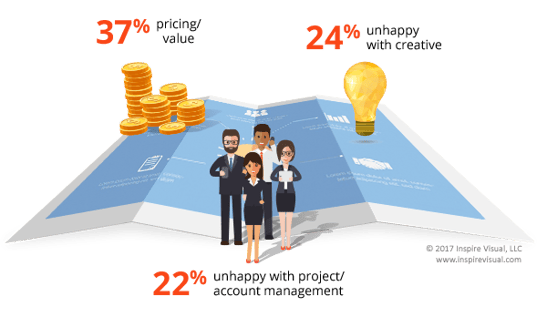
Another study found that customers thinking that you don’t care about them is the biggest reason why they leave your business. While this study covers all B2B businesses, the lesson isn’t lost on agencies
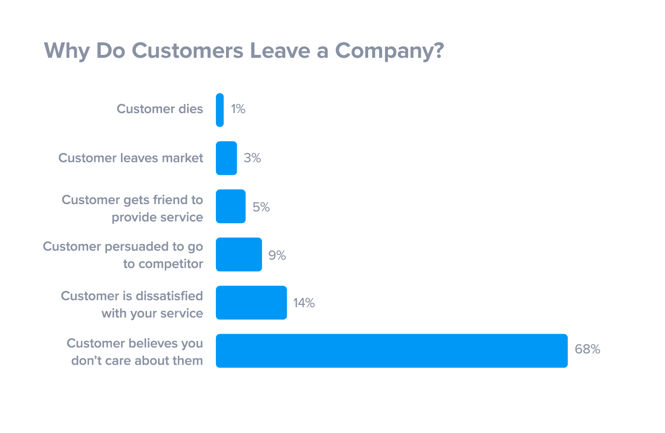
I don’t have to tell you that acquiring a new client is substantially more expensive than retaining your existing ones. If you dig through your agency’s financial data (read this guide to zoom in your true profitability), you’ll be surprised at the sheer magnitude of the difference.
On average, it costs nearly 5x more to acquire a new client than to retain an existing one.
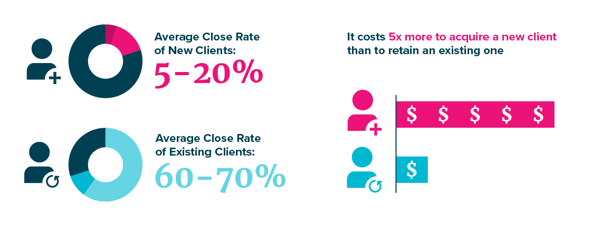
In other words, every $1 you spend on retaining a client comes back to you as $5.
It’s easy to see why this happens. An existing client already knows you - and vice-versa. You don’t have to build relationships from scratch, nor do you have to scratch through to understand their core problems and goals.
Upselling to existing clients, thus, is far easier - provided you approach it strategically.
Retention Marketing and Service Businesses
If you Google the term “retention marketing”, you might find that it focuses mostly on retaining customers for B2C businesses, especially for e-commerce businesses.
However, the philosophy and approach behind retention marketing are equally applicable to service-based businesses.
A popular retention tactic, for instance, is establishing a loyalty program. In B2C businesses, this might take the shape of discounts for repeat purchases. In service-based businesses, this might take the form of a referral program that rewards clients for sending qualified leads your way.
(Read more about building a scalable referral program for your agency)
While the specific tactics will vary, the core philosophy - keeping clients happy and gradually expanding the relationship - is the same for B2C and service businesses.
These similarities will be much clearer in the next section where we’ll share X client retention strategies.
5 Unmissable Client Retention Strategies
How exactly do you go about growing a client relationship? How do you turn one-off projects into recurring engagements? And what steps can you take to convince a departing client to stay?
I’ll share some answers below.
1. Keep tabs on client's happiness
The first step in retaining clients is to understand how happy (or not) they are with your agency.
While you might get a general feel for client happiness through your usual conversations, it helps to create a formalized process for measuring it.
Ideally, this process should factor in both objective and subjective feedback.
Two ways of doing this are:
- Client assessment calls: Every month, call each of your clients and ask how satisfied they are with your service. Also, ask if they’re on track to meet their marketing goals and if there have been any changes in their business situation. This will yield you subjective feedback.
- NPS (Net Promoter Score) Survey: Follow up your client assessment calls with an NPS survey. This survey asks clients to rate your service on a scale of 1-10. Anyone who scores you at 9 or 10 is labeled a “promoter”, while scores below 7 are “detractors”. The difference between your percentage of promoters and detractors is your NPS score. NPS gives you objective feedback.
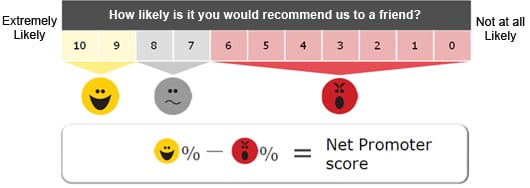
Together, these should give you a good understanding of the current status of your client happiness.
2. Identify “at-risk” clients
Unhappy clients - as measured by the subjective and objective feedback you gathered above - are at obvious risk of leaving your agency.
But client unhappiness isn’t the only risk category you have to watch out for. Happy clients might leave your agency as well in certain situations.
Usually, this happens when:
- Clients meet their marketing goals and no longer need your services
- Clients meet their marketing goals and no longer have the budget for your services
- Clients don’t know what other services you offer
- Clients are facing internal issues
- There have personnel changes on the client’s side, leading to budget cuts or reallocations
- External market circumstances don’t support the client’s current marketing activities
A lot of these are outside your control. If there is a new regulation that threatens the client’s business, that’s not something you can change.
However, by keeping tabs on these developments, you can better identify departing clients and take steps to retain them.
For instance, if you know that there has been a round of layoffs and budget cuts at the client’s company, you can offer them a discount or move them to a minimum retainer. This way, you don’t lose the client completely while they tide through their budget constraints.
How you keep tabs on your client’s business and industry is up to you. For most agencies, regular calls will reveal the state of your client’s business. But if that’s not enough, try reading blogs that cover the client’s industry, in addition to your client’s blog/social feeds.
This will tell you how the client’s company and the industry as a whole are faring.
3. Educate clients about your services and expertise
In a SODA survey, clients were asked to rank the top reasons why they left their previous agencies. Later, agencies were asked to rank the top reasons they thought clients left them.
The result of the survey was illuminating:
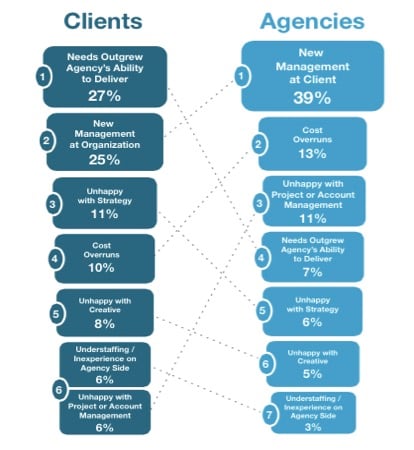
As you can see above, the biggest reason why clients left agencies was that they thought their needs outgrew the agency’s abilities.
Agencies, however, ranked this as the fourth biggest reason.
In other words, there is a mismatch between how clients and agencies evaluate the agency’s capabilities.
This mismatch often stems from ignorance. As an agency, you know what you’re good at, but does your client know the same? If you’ve added new capabilities since you first onboarded the client, did you care to educate the client about it?
This problem is particularly acute among agencies that specialize in vertical or marketing field. Their clients see them as specialized service providers (such as ‘SEO agency’) and don’t even ask what other services they offer.
The solution to this problem is twofold:
- Proactively ask what other digital services the client is in the market for
- Educate the client about your other services, new personnel additions, and new technologies, etc.
This doesn’t have to be a hard sell. Casually mentioning that your SEO agency just started a creative division, or that your content marketing agency just won a Webby award is good enough to remind clients about your capabilities.
4. Practice deliberate communication
If you’ve noticed, there is a common theme running through all three client retention strategies above:
Effective communication.
Communication is the foundation of strong client relationships. As we’ve written before, good communication is crucial for running better projects and keeping clients happy.
But if you want to retain and grow clients, it’s not enough to send articulate emails or send timely Skype updates; you must also practice deliberate communication.
This is communication with the specific goal of a) nurturing existing relationships, and b) expanding your relationships to new stakeholders.
For instance, good communication in a project would be sending regular status reports and getting sign-off on time.
Deliberate communication would be:
- Sending the client an article related to a competitor who is using a strategy that you’re selling
- Prospecting the client’s organization for relationships and stakeholders who might be interested in additional services
This is communication with a sales bedrock. If you sell PPC and SEO services, and you tell an SEO client about their competitor who grew 50% YoY with PPC, you get them thinking about hiring a PPC agency (i.e. you).
Your goal, of course, should be to help the client grow. You’re not hard selling any services; you’re simply nudging them in the right direction.
It’s a subtle tactic, but can be very powerful, especially if you already have a trustworthy relationship with the client.
5. Identify and nurture your key accounts
Dig through your financial data. What percentage of clients accounted for the bulk of your revenue?
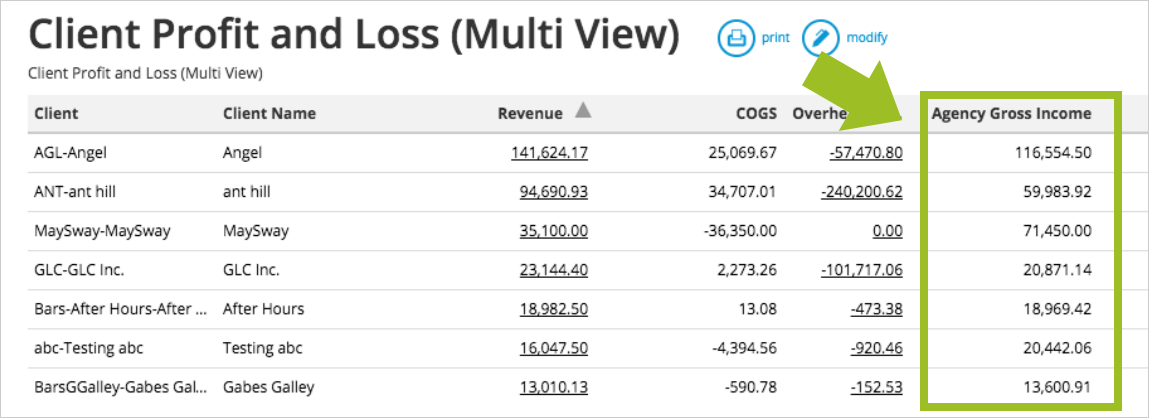
Workamajig’s detailed financial records can help you zero-in on your gross income for each client in no time
If you’re like most agencies, you’ll find that the 80/20 rule or Pareto Principle holds true for your revenues as well. That is, the top 20% of your clients account for 80% of your revenues.
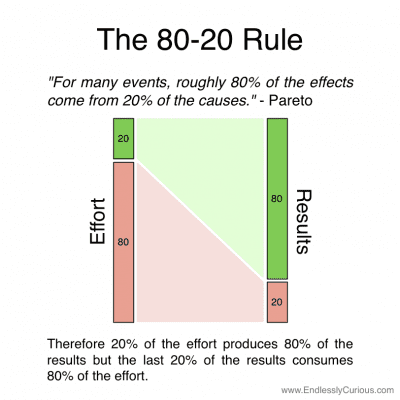
(Image source: SmartInsights.com)
These top 20% of clients form the core part of your Key Account Management strategy.
Key Account Management or KAM is the strategy that prioritizes and nurtures your top accounts. The goal of KAM is to develop strategic relationships with these top accounts in order to retain and grow them.
our top revenue-generating accounts are obvious candidates for KAM, you should also consider potentially high-value clients locked into low-value deals. For instance, if you have a Fortune 500 client engaged in a small-scale project, you should treat it as a key account since it has the potential to grow into a million dollar project.
In addition to potentially high-value clients, you should also include strategically important clients for KAM.
For instance, you might have one client in the B2B manufacturing vertical. If you want to expand further in this vertical, a case study from this one client can be very valuable. Thus, this strategically important client would be a Key Account Management candidate.
Key Account Management is a broad topic and deserves its own post. But for the most part, it involves:
- Highly personalized, high-touch service
- Customized, not boilerplate solutions
- Deep involvement of senior stakeholders in the project
Over to You
Winning new clients is great, but retaining your current ones can often be more profitable. It is also crucial for building a sustainable agency that clients love to work with.
Adopt these client retention marketing strategies to keep your existing clients happy. Use them right, and your clients will not only stick around but also give you more (and more profitable) business.
One way to keep on top of client relationships is by using a better agency management system like Workamajig. Workamajig’s agency-focused features help you understand your clients and their needs better.
Try a free demo to see how Workamajig can transform your agency.

